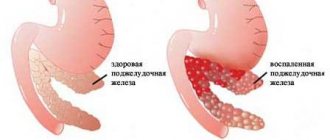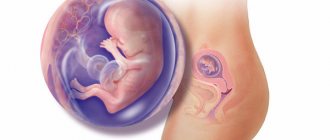Is it dangerous to suck in your stomach during pregnancy?
Author: Rebenok.online · Published 10/04/2017 · Updated 02/14/2019
Not all women want to demonstrate that they are in
an interesting position to others. But over time, the belly increases in size, and hiding pregnancy becomes problematic. In this case, the question arises whether it is possible to retract the stomach and whether this will harm the child.
Features of abdominal growth in pregnant women
The timing of abdominal rounding during pregnancy is individual for each woman. For some it forms at 2-3 months, for others it becomes visible only at 5-6 months. The intensity of its growth depends on muscle training, the place of attachment of the embryo , heredity and body type.
Attachment along the back wall of the uterus provides a small tummy during pregnancy. In this case, the child is located deep in the pelvis. Attachment along the front wall guarantees rapid growth of the abdomen .
According to statistics, women who play sports before conception change their figure much later. This is due to good muscle tone. A woman's weight is also important . For plump representatives of the fair sex, changes in appearance become noticeable later than for slender women.
The rate at which the belly grows also depends on the type of pregnancy. During the period of bearing the first child, it grows very slowly, since the muscles are not as elastic as those of multiparous women .
Is it possible to suck in your stomach during pregnancy?
The baby in the womb is protected by amniotic fluid. The peritoneal muscles serve as a reliable frame. When they are tense, the child does not feel significant discomfort, but regular squeezing of the muscles can harm him.
Before thinking about retracting the abdomen, you should analyze the feasibility of this action. To protect your child from unwanted problems as much as possible, it is recommended to adhere to the following principles:
- train the abdominal muscles at the stage of planning conception;
Sometimes tensing your abdominal muscles during pregnancy becomes problematic. The first trimester is characterized by gas formation. appears in the epigastrium , and its size increases. This process does not affect the fetus in any way, and the woman may not feel very well.
Possible consequences
At the initial stage of an interesting position, retracting the tummy will not lead to serious consequences if there is no risk of miscarriage. When threatened, any body movements can serve as a trigger. At later stages, the danger is as follows:
- lack of oxygen in the child;
Retracting the abdomen under the condition of a successful pregnancy does not pose any danger, but it is advisable to listen to the child. Positions in which internal organs are compressed bring him discomfort.
Why can't I pull my stomach in?
Any woman may experience the inability to retract her stomach. There is a feeling as if something is getting in the way in the pelvis .
There are several reasons for this phenomenon: First of all, you need to do a pregnancy test. If the result is negative, it is recommended to take a drug that eliminates bloating . The lack of positive dynamics indicates the need to visit a gastroenterologist. You also need to visit an ultrasound room to examine the pelvis.
The habit of keeping your abdominal muscles toned contributes to the appearance of beautiful posture and strengthens your back muscles. This helps when bearing a child . Doctors recommend doing exercises to develop your abs long before conception.
Author: fabrica · Published 02/11/2019
Author: Rebenok.online · Published 10/13/2017 · Last modified 02/14/2019
Author: Rebenok.online · Published 10/16/2017 · Last modified 02/14/2019
I don’t understand why one should suck in the belly during pregnancy and hide it, because a pregnant woman becomes even more beautiful, her tummy becomes rounder, the baby grows, develops in the tummy, learns new things, begins to push, what happiness this is. My friend didn’t know that when she was pregnant and in the early stages, she pumped up her abs and tried to get rid of her tummy, she didn’t yet know that she was pregnant, and when she found out so interestingly how she had changed so dramatically, she didn’t have a tummy like that yet, but she started to have pregnant gestures. The very next day she began to put her hand on her lower back and stick out her tummy. I wore a bandage during pregnancy, but it was uncomfortable for me, so I stopped wearing it completely. Before pregnancy, I had problems with my nose, I kept dripping into my nose, and during pregnancy I wanted to give up the drops, but if I didn’t drip into my nose, I felt like I was suffocating, and imagined what the baby inside me was experiencing with my lack of oxygen, so I continued to drip into the nose. And here I can imagine how the baby feels when mommy sucks in her tummy. Pregnancy is a wonderful time, don’t try to hide your belly, but inside the baby he feels everything and loves you, and loves it very much when you talk to him and stroke his tummy.
This site uses Akismet to reduce spam. Find out how your comment data is processed.
Pregnancy is a natural process!
Most women, when they become pregnant, begin to feel and behave as if they were crystal vases containing the world's most fragile jewelry. And if they stumble or falter, the treasure they carry within themselves will suffer or, even worse, perish. In fact, everything is completely different! Nature has provided everything in such a way that the fetus, while in the womb, is in the safest possible environment for itself. The baby in the stomach is protected by amniotic fluid, the uterus, and the abdominal cavity. All these barriers prevent compression and injury. Of course, mom needs to take care of herself when she is in such an interesting position, avoid blows to the stomach, avoid crowds on public transport, try not to fall, etc.
But there is no need to think every minute about whether it is possible to suck in the stomach during pregnancy or about what will happen if she lightly bumps into someone in the crowd. In 99.9% of cases everything will be fine with both the woman and her child! Elementary retraction of the abdomen, which occurs due to muscle tension in this area, cannot constrain the child or reduce the volume of the uterus. Until a certain period, by “shrinking” a little, the mother will be able to hide her position (up to a maximum of 14-15 weeks) - while the uterus is placed in the pelvis and abdominal cavity. Then, even if you suck in your stomach or not, it still won’t go away.
Is it possible to retract a pregnant belly? Belly during pregnancy.
Is it possible to pull in your stomach during pregnancy?
Many expectant mothers are very sensitive to their condition, especially if they are expecting the birth of their first baby. They are afraid of harming their child with a careless movement or action. Question: “Is it possible to pull in your stomach during pregnancy?” one of the most common during this period.
To begin with, it must be said that the child is reliably protected by amniotic fluid, which absorbs all movements and by the dense walls of the uterus. The peritoneum and abdominal muscles are additional “armor” for your baby. Therefore, if you consciously or subconsciously pull in your stomach during pregnancy, you will not be able to crush the baby or disrupt blood circulation in the pelvic organs. At a certain point, the muscles will get tired and relax.
There are exceptions to the rules. For some women, any physical activity is contraindicated during pregnancy. But if your doctor sees no reason to put you to bed before giving birth, then you have nothing to worry about.
However, it is worth remembering that squeezing your growing belly with tight clothing or a belt can be dangerous. This causes stagnation of blood in the pelvis and can cause oxygen starvation for the child.
Training and strengthening the abdominal muscles is the responsibility of every expectant mother. Even if you have never played sports, now you should do it for the sake of your baby. Special sets of exercises have been developed for pregnant women that allow you to carry a child without complications and maintain your figure. In addition, exercises during pregnancy. which require you to tighten your stomach, allow you to strengthen your abdominal and pelvic floor muscles.
Therefore, women who performed special gymnastics give birth faster than their “untrained” friends. Children born to physically active mothers are less likely to experience birth injuries. If the abdominal muscles are weak, then the birth process is delayed for a day or longer, and during this time the baby may suffer in the birth canal.
Therefore, you should not be afraid whether you can pull in your stomach during pregnancy, but on the contrary, do it more often and combine it with other exercises for the abs and back muscles. Do gymnastics for the sake of your beauty and the health of your baby.
Is it harmful to suck in your stomach?
There are ladies who claim that by drawing in your stomach and breathing deeply, you can get beautiful abs (almost with six-pack) without any effort (restricting yourself in diet, playing sports, etc.). A response chorus of voices claims that drawing in the stomach is harmful, because it tenses, and this leads to spasms. Experts have their own point of view on this matter.
Is it possible or not to suck in your stomach?
In fact, you can suck in your stomach, but you need to do it wisely. For example, if you are doing physical exercise. There is something in yoga when you need to draw in your stomach as you inhale, and relax it as you exhale. This way, the necessary pumping of the muscles of the anterior abdominal wall is achieved, the organs are saturated with oxygen (after all, the breath is very deep), and the nervous system finds harmony. Before you begin this exercise, carefully study the recommendations of experts on correct execution. If you feel unwell while doing it, stop.
On the other hand, constantly sucking in your stomach is extremely harmful. Indeed, because of this, posture is disrupted, the natural rhythm of breathing is disrupted, which leads to tangible health problems, because the organs are no longer supplied with oxygen in the required quantities.
In addition, when you suck in your stomach, your intestines also tighten. As a result of frequent abdominal retraction, digestive problems can occur. Squeezing the intestines, although not particularly strong, can still disrupt the natural process. If a person is prone to the formation of blood clots, even slight compression of the intestinal vessels can lead to quite unpleasant consequences and the development of severe complications.
How to correct your belly
You can correct your stomach using regular abdominal pumping. Of course, no one is stopping you from adding breathing practice - the results will appear faster.
Do not try to tighten your stomach with a belt or corset. You will simply overtighten it, which will cause the same problems as in the case of intestinal pinching.
Experts recommend learning not to suck in your stomach, but to tense your abdominal muscles. You don't have to breathe deeply to do this. You just need to be able to turn your muscles into stone. In this case, you will have beautiful abs without any harm to your health.
Is it possible to suck in your stomach during pregnancy?
Some ladies manage to suck in their stomach in the early stages of pregnancy. Doctors strongly advise against doing this. After all, let such a procedure not cause serious harm to the fetus. However, the baby may be uncomfortable from such experiments. If the pregnancy is problematic, such a procedure is strictly prohibited. After all, doing it incorrectly in this situation can easily lead to a miscarriage.
Is it possible to suck in your stomach during pregnancy?
Abdominal retraction is considered a very useful exercise. It allows you to strengthen the muscles in this area and perfectly tighten them. The habit of sucking in your stomach in everyday life has a positive effect on women’s posture. In combination with breathing exercises, this technique is very often used in yogic practice. Is it possible to suck in your stomach during pregnancy? After all, any expectant mother first of all thinks about her baby, especially if he is the first, fearing to harm him with some careless movements.
Is it possible to suck in your stomach during pregnancy?
To begin with, it’s worth taking a good look at the anatomy and structure of the female body.
Everyone knows that a child, while in the mother’s womb, is surrounded by amniotic fluid and elastic and dense walls of the uterus, which reliably protect him, absorbing all external actions. Therefore, he certainly cannot pull in his stomach, regardless of whether it was done consciously or unconsciously. In addition, the muscles simply cannot remain in a tense state for a long time and after a while they will relax voluntarily. Also, the above exercises do not lead to impaired blood circulation in the pelvis. Pregnancy is in no way a disease and everything proceeds absolutely naturally. But is it absolutely possible in all cases for pregnant women to retract their stomach without consequences?
How to treat stitches and stretch marks after a CS. Memo
When is there danger?
It is not recommended to practice retracting the abdominal muscles, especially for women for whom any physical activity is contraindicated for medical reasons. For example, with increased uterine tone. If the doctor strongly recommends that you take care during this period and be careful, you should listen to him. After all, we are talking about the health of the unborn baby.
There is also a great danger when unnatural pressure is applied to the pregnant woman’s abdomen. This may be caused by wearing tight clothing or a belt. Such actions lead to stagnation of blood in the pelvis, which is fraught with complications in the form of oxygen starvation of the fetus. Such situations should, of course, be avoided.
Video. Self-massage of the abdomen after childbirth
So, we have looked at cases when pregnant women can and cannot retract their stomach. In general, it is worth saying that physical activity is very important for an expectant mother. It will not only allow her to stay in shape, but also give birth easily and without problems. Abdominal retraction is always included in gymnastics for pregnant women. Before visiting the latter, it is advisable to consult a doctor.
Exercising during pregnancy
Doctors always warn their patients against excessive activity in the last trimester of pregnancy. At this time, they benefit from walks in the fresh air and breathing exercises. In the early stages, playing sports is acceptable if the woman led an active lifestyle before she became pregnant. Trained muscles need to be kept in good shape at all times.
Practical experience shows that those women who do not sit still during the nine months of pregnancy give birth easier and faster, they have better labor, fewer ruptures, and subsequent recovery is an order of magnitude more successful than those who were overly protective of themselves . But starting sports activities (especially for the purpose of weight correction) while carrying a fetus is strictly prohibited. An unprepared body may not be able to bear such a load, and there is always a risk of miscarriage.
Why does the stomach not retract in early pregnancy?
Primipara women often develop unmotivated fears that make them panic for any reason. Doubts arise about whether they are taking proper care of their health, whether they are doing everything to ensure that a full-fledged child is born. One of the exciting questions is whether abdominal retraction in the early stages of pregnancy is dangerous or not. In such cases, experts advise familiarizing yourself with the changes that occur after conception and attachment of the fertilized egg to the uterus.
Is it possible to pull in and tense your stomach in early pregnancy?
In the first months, it is not forbidden to wear tight clothes and shapewear. The embryo is very small, reliably protected by a special membrane and amniotic fluid. The wall of the peritoneum serves as resistant armor from direct pressure, so retraction of the abdomen cannot cause much harm to the embryo.
The muscles cannot withstand the described load for a long time. When they get tired, they spontaneously relax. During the short time they are contained, blood circulation in the pelvic area is not disrupted, so there is no need to worry. If the described circumstance is not a constant trend and the woman is completely healthy, nothing bad can happen.
Periodically drawing in your stomach and training your abdominal muscles before the upcoming birth is very useful. We need to keep them in good shape and strengthen them so that they help push the fetus out of the womb. For these purposes, special sets of exercises have been developed. Regular training will allow you to bear a child without problems and maintain a slim figure.
The practice of childbirth shows that women who exercise during pregnancy give birth easier, calmer, and without complications. With weak abdominal muscles, the birth of a baby can take a long time. The expectant mother will suffer incredibly. Often such conditions result in serious injuries.
Retracting the abdomen during a successful pregnancy does not pose any danger, but it is still advisable to listen to your own body and respond correctly to any discomfort that arises.
Possible consequences
Women who have a history of risk of miscarriage should not strain their stomach during pregnancy.
Any physical activity is contraindicated. It is necessary to maintain bed rest and make a minimum of movements. There can be no talk of any retraction (conscious or unconscious). As the period increases, such patients are advised to wear a special bandage - a product that supports the muscles of the peritoneum and lower back and relieves some of the load from them. Failure to comply with such requirements leads to the development of dangerous complications. A constantly retracting stomach will cause blood stagnation in the pelvis. This will cause fetal hypoxia. Oxygen starvation can lead to the death of an unborn baby.
Wearing tight underwear or girdles is considered potentially dangerous after three months. There are risks of increasing the tone of the uterus and the activity of the child in the womb. This phenomenon has nothing to do with the fetus’s communication with the outside world. He begins to move erratically when he experiences any physiological discomfort.
Why does the stomach not retract in early pregnancy?
There are conditions in which it is impossible to perform the described exercise. Often, when the muscles of the peritoneum are tense, there is a feeling that something is interfering in the pelvis. There are several reasons for this phenomenon.
Increased gas formation
As soon as the fertilized egg attaches to the walls of the uterus, increased synthesis of the hormone progesterone begins. It stimulates smooth muscle relaxation. This is necessary so that the reproductive organ does not push out the actively developing embryo.
Not only the uterus relaxes, but also the intestines. Peristalsis decreases. Food stays in the tract longer. Feces become compacted, decompose and rot. This process increases gas formation. It stimulates bloating, which makes retracting the abdomen impossible.
Hypertonicity
According to statistics, a similar condition is detected in six out of ten women in the early stages of pregnancy. It is diagnosed when the uterus is very tense and painful on palpation. The lower abdomen feels tight and feels like menstruation. In this position, it is strictly forbidden to strain the abdominal muscles: this can provoke a threat of miscarriage.
Sometimes such symptoms occur due to natural processes. A slight local inflammation develops at the site of attachment of the fertilized egg. It is a good sign that the placenta is beginning to actively form. The fetus grows quickly, the uterus is constantly increasing in size, and the ligaments that hold it in the correct anatomical position are stretched. This causes pain, which intensifies when the abdomen is pulled in.
Colitis of the lower intestine
With this disease, inflammatory-dystrophic changes occur in the thick segment of the tract. They can be provoked by various reasons: fungal, viral, bacterial infections, poisoning, food allergies, and taking certain medications. If a woman suffers from a chronic pathology, it may worsen during pregnancy. In this case, aching pain appears around the navel and in the iliac region. It intensifies with movement, with the act of defecation. In addition, heartburn and nausea are very bothersome. The general condition is deteriorating.
With colitis, severe discomfort prevents you from retracting your stomach. The action increases the pain, so instinctively the woman tries not to make any movements.
Neoplasm in the pelvis
Pregnancy can be carried to term if tumors are present.
This is a rather serious problem both for the obstetrician-gynecologist and for the expectant mother herself. If the benign nature of the neoplasm is confirmed, a wait-and-see attitude is adopted. The affected organ is under constant monitoring, which is carried out using ultrasound. If the growth of the tumor or cyst progresses noticeably, steps are taken to actively treat it. The neoplasm can cause severe discomfort during abdominal tension. When it appears, you need to contact a doctor and use a diagnostic examination to determine the cause of the ailment.
Muscle adaptation
The higher the gestational age of the fetus, the more the abdominal muscles lose their shape. Under the influence of hormones, they stretch and relax, allowing the womb to expand and create favorable conditions for the development of the unborn child. As a result, it becomes impossible to strain your stomach. This situation occurs when the first trimester ends and the second begins. The presence of such a condition does not impose a ban on gymnastics for pregnant women.
Is it possible to tighten the stomach immediately after childbirth?
How to remove belly fat after childbirth
Absolutely all women who have recently given birth are interested in how to remove belly fat after childbirth.
And those who believe that the belly goes away with the birth of a child are wrong. Firstly, the uterus contracts gradually, in some women up to 40 days, and accordingly the tummy remains visible to others. Secondly, in all healthy women, without exception, while carrying a child, fat is deposited on the abdominal wall, and a lot of it. In this way, nature takes care of the child’s safety. The fat layer on the abdominal wall of the uterus and the amniotic sac protect the baby from shock. Therefore, you don’t have to worry if you don’t fit into the doorway a little, the child won’t even feel the impact. But let’s return to the question of how to remove belly fat after childbirth quickly and effectively. If your health allows, you have experienced a natural birth and feel well, then already in the maternity hospital you can begin to put on a postpartum bandage that tightens the uterus, or, in the absence of one, wrap your stomach with a diaper. But this method is not for everyone. Many women after childbirth, due to prolonged contractions, experience pain in their abdominal muscles. Accordingly, the pain intensifies when they are compressed. If this happened to you, don’t worry about how to remove belly fat after childbirth at home after being discharged from the hospital. No medications will likely be needed. The uterus will contract on its own, returning you to your previous slimness. It will be more difficult to get rid of fat deposits, but this is also quite possible. And the speed of returning a slim figure largely depends on how many kilograms were gained during pregnancy. Agree, there is a difference between losing 5 kilograms and 15.
You will have to figure out the third point yourself, and we will talk about how to remove belly fat after childbirth, what exercises exist for this and how much you can eat.
Source
Can pregnant women suck in their stomach?
11/18/2017 Abdomen during pregnancy Retraction of the abdomen and breathing exercises are considered one of the constituent elements when doing yoga, fitness, and gymnastics.
This technique is a positive habit in everyday life - after all, an even, flat tummy is much more beautiful than a hanging fold. In addition, by tightening your stomach, you make your back and posture straighter. Is it possible to suck in your stomach during pregnancy? How appropriate and correct are these actions, and will such practice harm the intrauterine life and development of the baby? Initially, it should be explained that while inside the mother’s tummy, the baby is reliably protected by the elastic membranes of the uterus and the abdominal press. Amniotic fluid additionally protects the baby from the effects of external factors (blows, shocks, pressure), serving as a kind of shock-absorbing agent. Therefore, if you unconsciously or during physical exercises pull in your pregnant belly, you will not be able to harm the baby.
An exception to the rules are women who are at risk of bearing a child, for whom, due to important circumstances, physical activity is prohibited, and bed rest and rest are recommended.
Do not confuse pulling in the abdomen with tightening it with a belt, belt, or squeezing it with tight clothing. Such actions inhibit blood circulation in the pelvis, minimize the supply of oxygen and lead to oxygen starvation of the baby - hypoxia. You need to remember that the child inside you likes comfort and a cozy atmosphere. I note that special orthopedic bandages for pregnant women are not among the prohibited items that compress the abdomen. On the contrary, these are effective products that perform a medical function to facilitate pregnancy. They are often prescribed to women to minimize the load on the spine and internal organs, to support a heavy abdomen, and to prevent early labor.
Retracting the abdomen during pregnancy perfectly prepares the body, in particular the abdominal muscles and pelvic floor, for a quick and easy birth. Today there are many workouts - yoga, gymnastics for pregnant women, which involve special exercises aimed at making pregnancy easier and keeping mothers in shape.
Physical exercise, breathing exercises, and abdominal tightening are positive aspects during pregnancy. It is these loads that contribute to the rapid process of childbirth without any complications for the mother and injuries to the newborn.
It should be noted that it is the use of yoga with abdominal retraction and proper breathing that “calms” the muscles of the uterus during tone, Braxton-Hicks training contractions, and is an effective prevention for improving the well-being of a pregnant woman.
Pull and pull - there is a difference
So we figured out whether it is possible to retract the stomach during pregnancy, and in general, what exercises are acceptable for women during this period. It must be said that if accidental or deliberate retraction of the abdomen is not something dangerous, then tugging it is a huge risk.
Women need to wear clothes that will not put pressure on the abdomen and pelvic area, because even minimal discomfort in this area can lead to poor circulation and, as a result, fetal hypoxia. Lack of oxygen can cause the baby to lag behind in intrauterine development. However, this threat has nothing to do with wearing a prenatal bandage, which does not compress the stomach, but lifts it, that is, in many ways it performs the function of a woman’s weak muscular corset.
Summarizing the above, it is necessary to once again remind all expectant mothers that adequate physical activity contributes to the successful course of pregnancy and successful childbirth, so you should not deny yourself feasible training, but at the same time they should never forget about caution!
Is it possible to retract a pregnant belly at 16 weeks?
The question is disturbing. Is it possible to pull in your stomach during pregnancy? Is it true that if you lie on your back, your pregnant belly will not shrink in, but your fat will shrink? And in general, pregnant women and mothers, when taking pictures, did you suck in your stomach or relax it as much as possible? Or does it no longer matter there, because it is impossible to tense/retract it?
Woman.ru experts
Find out the opinion of an expert on your topic
Ekaterina Gomez Suarez
Psychologist, Psychologist-consultant. Specialist from the site b17.ru
Sheludyakov Sergey
Psychologist, Clinical psychologist. Specialist from the site b17.ru
Dyachenko Elena Vladimirovna
Psychologist, Gestalt therapist in training. Specialist from the site b17.ru
Natalya Maratovna Rozhnova
Psychologist. Specialist from the site b17.ru
Sokol Larisa Ivanovna
Psychologist, Gestalt therapist. Specialist from the site b17.ru
Pustovoitova Elena Yurievna
Psychologist. Specialist from the site b17.ru
Muratova Anna Eduardovna
Psychologist, Online consultant. Specialist from the site b17.ru
Slobodyanik Marina Valerievna
Psychologist. Specialist from the site b17.ru
Alexander Trofimov
Psychologist, Online consultant. Specialist from the site b17.ru
Why is it considered wrong to stroke a pregnant belly?
A pregnant lady at all times and peoples has been something completely special. The mystery of the birth of a new person can perhaps be called the most interesting and exciting. Since women consider the belly to be a kind of personification of this secret, all people, when they see this protruding part of the body, unconsciously have a desire to touch it. But not all women encourage this desire. Moreover, there is an opinion that this is absolutely not worth doing. Why can’t you touch and stroke a pregnant woman’s belly? What are these prohibitions related to?
To touch or not to touch
Everyone knows and understands that how the pregnancy proceeds will greatly affect the health of the unborn baby. Maternal health, both psychological and physical, is the main condition for the survival of the fetus. The universal desire of relatives to touch the belly of a pregnant mother can be explained for various reasons. Thus, it is known that in many cultures, including Rus', they believe that an unborn child is possessed by a certain spirit of an ancestor, whom they tried in every possible way to appease. People want to believe that after their death, souls will return to the mortal earth in the guise of their descendants. In order not to cause the indignation of the gods, they tried to protect the pregnant mother in every possible way. The desire to touch the stomach is precisely associated with the fact that people unconsciously try to protect the life that has arisen inside. In addition, in this way people strive to touch the greatest secret of humanity.
Nowadays, it is believed that if you touch a pregnant woman's belly, it will definitely bring good luck. There is even a sign that says that if you hold your wives' belly
Source
User information
Discovering the secrets of “Magical Skin”
Each section of the site specializes in a specific topic.
“Skin types” helps you determine your skin type: dry, oily, combination? This is very important in order to understand the problem and solve it competently. Tests and articles in this section help even inexperienced girls find out their skin type.
“Face and Body Skin Care” knows everything about daily beauty procedures:
- How to care for young skin of the face and body.
- How to maintain fading beauty and look younger than your peers.
- How to remove swelling, bruises, bags under the eyes.
- Seasonal care - how to look good at any time of the year.
- Section "Pregnancy" for expectant and nursing mothers.
- How to do depilation on the face and body.
Both young girls and experienced women worry equally strongly if a rash appears on the skin. Pimples, freckles, moles, warts can really ruin your mood. The section “Problem skin” will relieve tears and despair and tell you:
- How to cleanse the skin of your face and body correctly.
- How to treat skin inflammation (pimples, acne, blackheads).
- What to do, if
Many expectant mothers, especially those from the ranks of athletes, often wonder whether it is possible to retract the stomach during pregnancy. Some people have to tense their abdominal muscles during exercise, others do it out of habit - to look slimmer and fit. Is there any danger in this for the unborn child or, on the contrary, is this exercise useful and will help a woman bear a healthy baby and give birth without problems and much effort?
Rules for belly growth during pregnancy
Changes in the shape and growth of the abdomen during pregnancy. Stretch marks during pregnancy
One of the undeniable signs of pregnancy is an enlarged belly. Why and how does it grow? It would seem that the answer is obvious: the belly grows because the child is growing in it, and this happens in the same way for all expectant mothers, because any normal pregnancy lasts 9 months. In fact, everything is much more complicated, and the characteristics of abdominal growth can tell a specialist a lot...
Fruit size
The size of first the fertilized egg and then the fetus is determined by the results of an ultrasound examination (ultrasound). With the help of transvaginal ultrasound (the sensor is inserted into the vagina during this study), the fertilized egg can be detected after 2-3 weeks of its development; the gestational age, which is counted from the first day of the last menstruation, is 6-7 weeks at this time. The diameter of the fertilized egg at this stage is 2-4 mm.
Uterus dimensions
The uterus increases in size throughout pregnancy. For the first few weeks, the uterus is pear-shaped. At the end of the 2nd month of pregnancy, its size approximately triples and it has a rounded shape. During the second half of pregnancy, the uterus retains its round shape, and at the beginning of the third trimester it acquires an ovoid shape. Before pregnancy, the weight of the uterus averages 50-100 g, and at the end of pregnancy - 1000 g. The volume of the uterine cavity at the end of pregnancy increases by more than 500 times. During pregnancy, each muscle fiber lengthens 10 times and thickens approximately 5 times. The vascular network of the uterus increases significantly; in terms of its oxygen regime, the pregnant uterus approaches such vital organs as the heart, liver and brain.
These parameters can be determined by measuring the uterus using naru techniques
Source








